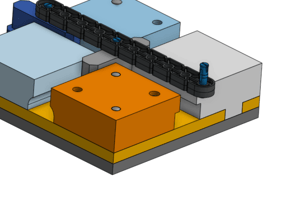Podcast
Questions and Answers
What type of epithelium lines the duct of the epididymis?
What type of epithelium lines the duct of the epididymis?
- Simple cuboidal epithelium
- Simple columnar epithelium
- Pseudostratified columnar epithelium (correct)
- Stratified squamous epithelium
What is the primary function of the ductus deferens?
What is the primary function of the ductus deferens?
- To store seminal fluid
- To facilitate the absorption of nutrients
- To transport sperm during ejaculation (correct)
- To produce sperm
What characterizes the muscular layer of the ductus deferens?
What characterizes the muscular layer of the ductus deferens?
- It includes longitudinal and circular layers. (correct)
- It consists of a single layer of smooth muscle.
- It is developed only in the ampulla region.
- It has only circular muscle fibers.
Where does the ductus deferens empty into?
Where does the ductus deferens empty into?
What feature of the ductus deferens mucosa is noteworthy?
What feature of the ductus deferens mucosa is noteworthy?
Which structure joins the ductus deferens at the ampulla?
Which structure joins the ductus deferens at the ampulla?
What is notable about the thick muscularis of the ductus deferens?
What is notable about the thick muscularis of the ductus deferens?
What is the composition of the connective tissue surrounding the epididymis?
What is the composition of the connective tissue surrounding the epididymis?
What type of epithelial cells line the mucosa of the ductus deferens?
What type of epithelial cells line the mucosa of the ductus deferens?
Which of the following roles do the accessory glands of the male reproductive tract NOT perform?
Which of the following roles do the accessory glands of the male reproductive tract NOT perform?
What is the primary function of the secretions produced by the seminal vesicles?
What is the primary function of the secretions produced by the seminal vesicles?
What unique feature characterizes the mucosa of the seminal vesicles?
What unique feature characterizes the mucosa of the seminal vesicles?
How do the seminal vesicles contribute to semen's properties after ejaculation?
How do the seminal vesicles contribute to semen's properties after ejaculation?
Which term best describes the structural arrangement of the seminal vesicles?
Which term best describes the structural arrangement of the seminal vesicles?
What is the correct order of the smooth muscle layers surrounding the seminal vesicles?
What is the correct order of the smooth muscle layers surrounding the seminal vesicles?
Which accessory gland produces the majority of seminal fluid?
Which accessory gland produces the majority of seminal fluid?
Flashcards are hidden until you start studying
Study Notes
Epididymis
- The duct of the epididymis is surrounded by connective tissue containing blood vessels.
- The duct is lined with a pseudostratified columnar epithelium with long stereocilia.
- The duct is lined with a thin layer of smooth muscle which thickens in the body and tail of the epididymis.
- The lumen of the duct contains sperm.
Ductus (vas) Deferens
- It is a long, straight tube with a thick, muscular wall.
- It begins at the tail of the epididymis and ends in the prostatic urethra.
- It transports sperm from the epididymis during ejaculation.
- It has a narrow lumen and a thick layer of smooth muscle.
- Its mucosa is folded longitudinally and lined by pseudostratified columnar epithelium with sparse stereocilia.
- The lamina propria is rich in elastic fibers.
- The muscularis has longitudinal inner and outer layers, and a middle circular layer.
- The muscles produce strong peristaltic contractions during ejaculation, moving sperm along the duct from the epididymis.
- It forms part of the spermatic cord which contains the testicular artery, the pampiniform plexus, and nerves.
- After passing over the urinary bladder, it dilates into an ampulla, where the epithelium is thicker and more folded.
- The seminal vesicles join the duct at the final part of the ampulla, leading to the prostate gland and opening into the prostatic urethra.
- The segment entering the prostate is called the ejaculatory duct.
- The mucosa of the ductus deferens continues through the ejaculatory duct; however, the muscle layers disappear beyond the ampulla.
Accessory Glands
- The accessory glands produce secretions that are added to sperm during ejaculation to produce semen.
- The accessory genital glands are:
- Seminal vesicles
- Prostate gland
- Bulbourethral glands
Seminal Vesicles
- They consist of highly tortuous tubes about 15cm in length.
- The mucosa has many thin, complex folds that fill most of the lumen.
- The folds are lined by simple or pseudostratified columnar epithelial cells, which are rich in secretory granules.
- The lamina propria contains elastic fibers and is surrounded by smooth muscle with an inner circular and outer longitudinal layers.
- They are exocrine glands that produce a viscid, yellowish secretion.
- The semen components produced by these glands make up about 70% of the ejaculate. They provide nutrient energy sources for the sperm, coagulate semen after ejaculation, and affect activity of the female reproductive tract.
Studying That Suits You
Use AI to generate personalized quizzes and flashcards to suit your learning preferences.




